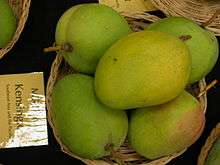Kensington Pride

The 'Kensington Pride' mango is a named commercial mango cultivar that originated in Australia. It is sometimes called the KP, Bowen or Bowen special. It is Australia's most popular mango, accounting for over 80% of the country's annual commercial mango market.
In Australia, commercial Kensington Pride mangoes grow predominantly in the Northern Territory and northern and central Queensland, providing early (September–November) and late season (December–February) mangoes respectively. Some late-season fruit are from the Kununurra region in Western Australia. Very few commercially available fruit come from south-east Queensland or northern New South Wales, and fruit from these latitudes is generally of lower quality.
History
The original tree was grown in Bowen, Queensland and described in the 1960s,[1] where it was also given the name "Pride of Bowen" and "Bowen Special". It was possibly brought to Bowen by traders who were shipping horses for military use in India.[2]
'Kensington Pride' was recognized for its flavor and became the most widely grown commercial mango in Australia, and remains so today[3] despite the introduction of other varieties. It is grown widely in the tropical and sub-tropical regions of the country. 'Kensington Pride' was also introduced to the United States via Florida, where it is sold on a limited-basis as nursery stock for home growing. 'Kensington' trees are planted in the collections of the USDA's germplasm repository in Miami, Florida,[4] the University of Florida's Tropical Research and Education Center[5] in Homestead, Florida, and the Miami-Dade Fruit and Spice Park,[6] also in Homestead.
Description
'Kensington Pride' fruit average around a 500 grams in weight at maturity. They are ovate in shape and have a rounded apex, generally lacking a beak. The skin color is yellow, developing some red blush. The flesh is yellow, with moderate fiber, and has a sweet and spicy flavor. The fruit contains a polyembryonic seed.
Production
The fruit ripens from mid-September to March in Australia depending on the region it is grown, and typically ripen in July in Florida. 'Kensington' fruit production is considered moderate and inconsistent in Australia, with fruit having moderate disease resistance. The cultivar is exceptionally erratic, with wide year-on-year variation in fruit output and quality.
In Australia, the mango season spreads southward from September through February. The mango season begins near Darwin and Katherine late September and ends by early December. Queensland varieties (from such locations as Mareeba, Dimbulah, Townsville, Bowen and Yeppoon) enter the market around this time and persist on the market well into January. In the 1990s and 2000s, the number of mangoes coming from the Northern Territory has increased substantially.
Trees are moderately vigorous growers and can reach heights over 8 metres (25 feet) if left unpruned.
References
- ↑ http://www.crfg.org/pubs/ff/mango.html
- ↑ http://www.hort.purdue.edu/newcrop/morton/mango_ars.html
- ↑ http://www.dpi.qld.gov.au/26_18931.htm
- ↑ http://www.ars-grin.gov/cgi-bin/npgs/acc/display.pl?1081340 USDA, ARS, National Genetic Resources Program. Germplasm Resources Information Network - (GRIN). [Online Database] National Germplasm Resources Laboratory, Beltsville, Maryland.
- ↑ http://trec.ifas.ufl.edu/crane/pdfs/TREC-Fruit-Collections.pdf
- ↑ http://fruitandspicepark.org/friends/index.php?option=com_content&task=view&id=43&Itemid=29